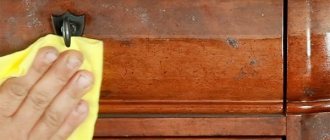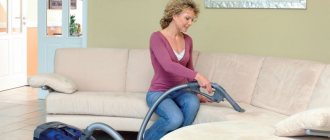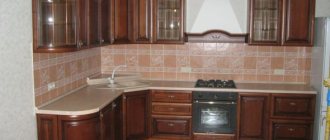- Mustard powder
Keeping the kitchen clean is one of the main tasks of housewives, so the question of how to clean grease from kitchen furniture at home is always relevant. Home and professional remedies will help clean surfaces and restore their freshness. However, in order not to damage the headset, it is important to know what material it is made of and take into account the features of caring for it.
Even the most careful and clean housewife often has traces of grease and soot in her kitchen. General cleaning using household chemicals or folk remedies will help restore the cleanliness and shine of the set.
The article contains useful tips and effective methods that will help remove grease from glossy, plastic and wooden furniture in the kitchen.
A few recommendations
It happens that after a hard day at work and a second shift in the kitchen, you are so tired that you no longer have the strength or desire to wipe all the kitchen furniture. It happens that you are simply too lazy to do this, but it happens that you inherited a kitchen set from previous residents in a rented apartment, and it is clearly noticeable from it that, to put it mildly, not very neat people lived before you. The situations are different - the result is the same. This is a greasy coating that you can’t handle with your bare hands.
There are two ways to clean your cabinets from grease . These are household chemicals and folk remedies . Actually, choosing one of the two methods divides all housewives into two camps. Fans of household chemicals believe that this is a more effective and faster way to achieve the desired result, while opponents note that speed and effect are often achieved in a not entirely safe way, pointing to the toxicity of store-bought products. Traditional methods, according to their fans, are no less effective, but they are completely safe, and the necessary components are inexpensive and can be found in any apartment.
Whatever method you choose, keep in mind a few important rules:
- If household chemicals are used, then you must carefully study the label and instructions for use. Pay attention to what surfaces the product is intended for and in what concentrations it can be used;
- Some cleaning products can corrode plastic and paint, leaving whitish spots on them. If you are not sure that the chosen product is safe, it is better to test it on the most separate section of the kitchen facade;
- to clean kitchen furniture from grease using soft materials - put hard metal sponges aside. Microfiber, cloth, flannel are suitable. Hard bristles can scratch the kitchen façade. At best, the fatty deposit will not be completely removed, and scratches on it will become a place for further accumulation of dirt;
- To clean kitchen furniture, do not use abrasive products that can scratch the surface. Preference is given to liquids, gels and pastes;
- It is better to carry out cleaning with gloves. This applies to both working with household chemicals and folk recipes;
- when using household chemicals, make sure the room is well ventilated;
- heavily soiled surfaces will have to be washed in several stages, each time applying the selected product for 30 minutes and rinsing it off, so don’t worry if some stains cannot be removed the first time.
When the general rules are known, you can move on to specifics and find out how to remove grease from furniture in the kitchen.
Options for kitchen facades
For the production of kitchen furniture, wood, plastic, glass, including frosted glass, MDF, chipboard (plain and laminated) are used. Each material has its own characteristics that should be taken into account when starting general cleaning.
Wooden facades are difficult to clean. To wash away grease and other contaminants, use soft, lint-free wipes and special compounds for wood. After cleaning, wipe all surfaces dry and treat them with wax or polish. This will protect the wood from dust and other contaminants.
The wooden facade of the kitchen looks very presentable, stylish and majestic. However, wood is very sensitive to the effects of chemicals, which must be taken into account when choosing a method for cleaning the set
The plastic set is the simplest and most unpretentious in terms of maintenance. It is resistant to moisture and organic substances. This not only makes it easier to maintain the facades, but also guarantees them a long service life while maintaining a presentable appearance. You can wash off grease from plastic in the kitchen using special products or traditional methods without fear of damaging the material.
To clean glossy MDF , do not use hard sponges or substances with abrasive particles. They scratch the surface and spoil the aesthetic appearance of the furniture. When working with gloss, give preference to soft cloths and gentle detergents. After cleaning, rub the surfaces well to restore their original shine.
Regardless of the material of the kitchen set, do not use aggressive chemicals, substances with large abrasive particles, hard brushes or sponges to clean it. This will lead to damage to the surfaces and loss of presentable appearance.
No. 1. Household chemicals
Household chemicals allow you to achieve the fastest results. It is only important to choose a composition that is optimally suited for a particular surface. For example, facades made of MDF and finished with film or plastic cannot be washed with products based on chlorine and abrasives. A reputable manufacturer provides a list of surfaces that can be cleaned with a specific product.
The choice of all kinds of substances is huge. Some of the most popular are products from the brands “Mister Muscle”, “Santry”, “Shumanit”, “Sanita”, “Silit Bang”, “Gala” and some others. Each bottle will indicate the method of use, but often it consists of the following:
- rinse the contaminated surface with warm water;
- apply detergent, rub with a sponge/rag;
- wash off any remaining detergent from the surface;
- repeat the process if necessary;
Let us repeat that when working with chemicals, it is important to wear gloves, since potent components can damage the skin. Sometimes the respiratory organs also need protection, but if you suffer from allergies or bronchial diseases, then it is better to replace household chemicals with traditional methods.
Folk remedies do not cause allergies, will not damage the surface, are inexpensive, can be made even without going to the store, but at the same time, in terms of effectiveness, they are practically not inferior to toxic household chemicals, so we will pay maximum attention to them.
Removing fat using a steamer
PURPOSE: To remove old fatty deposits from all kitchen surfaces, except wood (!).
INSTRUCTIONS:
If you have a clothes steamer, you can use it to treat the entire kitchen, from the fronts to the backsplash. The method is good for its simplicity and effectiveness. After such a “bath”, the kitchen must be washed with soap and water, and then with a clean, damp and dry microfiber cloth.
- It is recommended not to steam the edges, as this is the weakest point of any furniture made of MDF and chipboard.
No. 2. Soda + vegetable oil
This is one of the most effective ways to clean grease from kitchen cabinets , suitable for all types of surfaces, incl. and for wooden facades. It is necessary to mix soda and vegetable oil in a ratio of 2:1, you will get a thick paste with a consistency like sour cream. The mixture is applied to the stained areas; they can also be gently rubbed with a sponge, but do not overdo it. Then the pulp should be left for 15-30 minutes, after which it should be wiped with a damp sponge. The fat particles should literally fall off. If all contaminants cannot be removed, you can repeat the procedure. In order not to stain the entire kitchen with such a mixture and particles of waste fat, it is better to lay newspaper under the surface to be cleaned.
The vegetable oil contained in the product nourishes wooden surfaces well and forms a kind of protective film on them, which allows you to hide minor abrasions, scratches and other defects. We get 2-in-1.
No. 3. Ammonia
Ammonia can also be found in any apartment. To prepare a cleaning agent from it, just dissolve 1 tbsp in 1 liter of water. a spoonful of ammonia. All contaminated surfaces are treated with the resulting solution. It is most convenient to apply the liquid from a spray bottle, but you can use a sponge or rag. Leave the solution on the surface for a few minutes, after which you can gently rinse it off with a damp sponge. This method will allow you to cope with a small plaque. To remove more serious stains, it is better to leave the product on for 15-20 minutes.
How to care for natural wood furniture
Wood furniture should not be wiped with a wet or even damp cloth, because... she is very sensitive to moisture.
In order to cause minimal damage to your favorite furniture, cleaning should be done only with cloth or a dry flannel cloth.
- Particular care should be taken when handling furniture made from valuable wood. Such furniture must be limited in contact with very hot and very cold dishes, because... she may leave marks. In order to avoid this, you need to use various stands, tablecloths, etc.;
- Veneered furniture should be wiped with a slightly damp cotton cloth. Among other things, there are a number of delicate products. which will help in caring for this type of furniture;
- To care for wooden furniture, products are now available for sale in the form of liquids, aerosols, pastes and special wipes. Also, do not use solvents on this type of furniture.
- Cleaning preparations for such furniture are: oil-based and wax-based:
- Oil-based products are great for cleaning and protecting any wooden surfaces. Oil cleaning compositions gently care for wood, efficiently remove dirt, give shine and fresh color;
- Wax-based products are used for polishing purposes. Using wax products you can prevent the formation of dirt, scuffs and small scratches. They do not leave streaks, have dust-repellent properties and have an antistatic effect, which together helps keep polished furniture in perfect condition.
If you are afraid of products containing chemicals, try any of the presented folk remedies
The best way to remove dust on wooden furniture with an uneven surface is a special furniture brush.
In order to clean wooden furniture, you need to mix 1 tbsp. spoon (15 ml) olive oil and 2 tbsp. tablespoons (30 ml) lemon juice or vinegar. Spray the mixture from a plastic spray bottle or dampen a clean, soft cloth with it and wipe the wood furniture. Vinegar removes dirt from wooden surfaces, and oil prevents them from drying out.
- In order to polish wooden furniture, you need to take lemon oil - because it restores shine and acts as an antiseptic. To get a natural shine for furniture with a pleasant smell, you need to combine 10 drops of natural lemon oil and 2 tbsp. spoons (30 ml) of lemon juice, then pour in 5 drops of quality olive oil or jojoba oil. Lightly wet a clean flannel cloth with this mixture and rub the furniture until it shines;
- To clean light unpolished wood furniture. In a clean bowl, heat white stearin with gasoline (1:1) to form a thick mixture. Then cool it and use a soft cloth to rub the entire surface of the furniture. After two hours, polish it with a clean flannel cloth.
- Oak furniture, especially greasy stains on it, should be cleaned with warm beer. To give it shine, you need to wipe it with a cotton swab moistened with a boiled and then slightly cooled mixture of beer (1 glass), sugar (1 tablespoon) and wax (20 g). For these purposes, you can buy wax in hardware stores or crumble wax candles. The mixture is boiled in a water bath. The mixture is still hot, but not too hot, evenly applied to the fabric, lightly squeezed and greasy stains are carefully wiped off with vertical movements. There is no need to rub the greasy stain. After the surface has dried, the furniture is polished with a woolen cloth.
- It is recommended to wipe mahogany furniture with a cloth moistened with vegetable oil. If you have expensive walnut cabinets and tables, you can tidy them up with olive oil and red wine.
- Unpolished furniture should be cleaned with a vacuum cleaner with a soft attachment or wiped off dust with a soft, dry cloth. You can periodically wipe it with a damp swab, and if it is very dirty, wash it with warm water and soap and wipe dry.
- White furniture should be cared for using low-fat cream or milk. After treating the furniture surface with it, you should wipe it with a woolen rag.
- To remove scratches from oak or walnut furniture, you can disguise them by rubbing a weak iodine solution into them with a cotton swab. You can rub a little shoe polish of a suitable color into a shallow scratch on a polished surface and polish it with a cloth. Try filling in the scratch with a felt-tipped marker. You can find these markers in a variety of wood tones at hardware stores. Apply the marker directly to the scratch. If you get a felt-tip pen on an undamaged surface, wipe it off immediately. You can also rub the scratch with a wax-based colored chalk that matches the color. Also, at a furniture or hardware store, buy furniture wax to match your furniture. Wax can be soft or hard, in the form of pencils or blocks. You can also get rid of scratches using a special mastic. To prepare it, dissolve 4 parts wax in 3 parts turpentine over low heat, then stir, pour 2 parts alcohol into the mixture and stir again. Before treating with mastic, scratches are wiped with a piece of woolen cloth dipped in clean aviation gasoline. Then apply mastic with a cotton swab and rub until shiny with a soft woolen cloth. The mastic should be stored in a glass jar with a ground stopper.
- A water stain can be sprinkled with flour and wiped off with a swab dipped in vegetable oil.
No. 4. Baking powder
Another component that can be found in almost every apartment. You need to add a little water to the powder to get a paste, which should then be applied to contaminated surfaces and left for 20-30 minutes. The powder will gradually acquire a yellowish tint - this is a consequence of fat acidification. All that remains is to wash off all the dirt with a damp sponge and wipe the surface dry.
No. 5. Mustard powder
This method cannot be called universal . It is suitable for facades with a good protective coating, as well as for sinks, refrigerators, stoves, and tiles. It is not recommended to use it for cleaning wooden surfaces.
Mustard powder has been used for many decades by domestic housewives, who have realized that it perfectly dissolves fatty contaminants. To deal with greasy deposits, just moisten the contaminated area and sprinkle it with mustard powder. All that remains is to gently rub it with a dry cloth, then use a damp sponge or rag to remove it along with the particles of removed fat. The bulk of the dirt should remain on the napkin.
Steam cleaner
A steam cleaner (or steam generator) will remove remaining scale or oil traces, congealed grease, as well as fungus and foreign odors. Under the influence of temperature, old grease stains can be washed away. It can be used on all surfaces that are not harmed by moisture: glass, tiles, steel, wood - with caution. After treating the kitchen with a steam generator, it is enough to remove any remaining moisture and dirt with a napkin.
No. 6. Alcohol + vinegar
How to remove grease from kitchen furniture if not with alcohol! Mix alcohol or vodka with table vinegar and water in a ratio of 1:1:2. You can add essential oil (any oil to your taste) to the solution to get a pleasant aroma after washing. The mixture must be generously applied to the kitchen furniture (you can also apply it to the stove, sink, refrigerator) and leave for 10-15 minutes, after which all stains, grease stains, plaque and other contaminants should come off very easily. Housewives note that this composition copes well with limescale deposits on tiles, ceramics, and water taps.
No. 7. Alcohol
Alcohol can also be used solo, without other components. The sponge is well moistened with alcohol or vodka, and then the surfaces of the kitchen set are wiped with it. Light stains will come off almost immediately, but to deal with more serious stains, it is better to moisten the surface with alcohol and leave for 15-20 minutes, after which the remaining dirt and alcohol are removed with a sponge. After such manipulations, it is recommended to treat the furniture with a solution of a few drops of eucalyptus or spruce essential oil in a glass of water. This will create a pleasant aroma in the kitchen and nourish the furniture.
How to restore pure shine to glass
Especially a lot of dirt collects on the oven glass. No matter what substances you use afterwards, it is almost impossible to clean it. In this case, soda will give the most positive effect.
First, the oven door is rubbed with powder. Afterwards, a weak solution of vinegar is sprayed from a spray bottle. Use a soft cloth to treat contaminated areas. Remove residues with a dry cloth. If you use a damp cloth or liquid, streaks will remain.
Clean the glass hob after it has cooled completely. You should also unplug it from the network. Old marks can be easily cleaned with a mixture of lemon juice and soda.
You can wash furniture with frosted glass using the following compounds:
- Chalk. Take about 50 g of powder and add 230 ml of water. Use a brush to remove stains. After drying, the chalk is removed with newspaper or dry napkins.
- Ammonia. It is necessary to dilute 4 tablespoons of ammonia in 0.5 liters of water. Wipe the glass with the resulting liquid and immediately wipe it with a paper napkin. This will help avoid divorces.
To remove carbon deposits on a glass surface, use dishwashing liquid. It adds shine and removes cloudy stains, so you can wipe glass with it every day.
No. 9. Citric acid + detergent
To make this product, you need to add 15 g of citric acid and a couple of drops of dishwashing detergent to 1 liter of water, mix well and spray the resulting solution on contaminated surfaces. It is better to leave the product for 30 minutes so that it thoroughly breaks down the fat. Next, as usual, rub particularly dirty areas with a sponge and treat all surfaces with a damp sponge.
How to clean varnished surfaces
Abrasives are not suitable for varnish at all. Aqueous solutions, such as soap, are also not recommended, because they can promote peeling of varnished coatings. As a traditional method, you can use baking powder diluted with water as a cleaning composition. With this gruel you need to vigorously rub the greasy deposit and remove its remnants using a damp and then dry cloth.
If you are not sure about the effect of baking powder, take a store-bought product. It can be liquid or foamy. Do not rub the surface, but leave the product to interact with the plaque. This way you can avoid even the smallest scratches.
No. 10. Fresh lemon
If the situation is not very bad, then you can clean the furniture from grease using a slice of lemon. It is necessary to thoroughly rub the contaminated surface with it, so that the juice literally drips off. As in previous cases, leave the product for 20-30 minutes, then rinse it off with a sponge soaked in warm water. It may take a little effort here and there. After completing all the manipulations, all that remains is to wipe the furniture dry with a paper towel. The pleasant citrus aroma will be a bonus.
Rules of application
Shake the bottle of liquid before use. Then spray from a distance of 20 centimeters onto stains or streaks of fat. The gun or bottle must be held vertically.
Before spraying, it is worth testing the cleaning concentrate on a small area of furniture that is not visible to the eye. If the reaction of the façade material is negative, then another chemical is used to remove grease. It is advisable to put rubber gloves on your hands before cleaning and protect your mucous membranes with a mask. You need to use one product, without mixing it with others.
No. 13. Soap + soda
Grease actively settles not only on kitchen cabinets, but also on the tiles of the work apron. In this case, you can use the following method. Laundry soap is grated on a coarse grater and dissolved in water. The result should be a cloudy solution, which is used to thoroughly wipe the surface. After this, soda is applied to the sponge, which must be used to treat the surfaces. Leave the active ingredients for 15-20 minutes, after which everything can be washed off with a sponge soaked in warm water. Laundry soap can be replaced with regular detergent. The method is very effective, but is not suitable for furniture, especially with a glossy surface , since soda particles can leave scratches.
No. 14. Steam cleaning
If you have a clothing steam generator at home, it can also be used as a means of cleaning kitchen surfaces. It is not advisable to buy it only for cleaning kitchen cabinets - such equipment is not cheap. If during normal sponge washing the water temperature cannot reach higher than 400C, then the water comes out of the steam generator in the form of steam, i.e. has a temperature above 1000C. Due to this, the method has many advantages:
- dirt literally flies off surfaces;
- You can even remove old fat that cannot be removed in any other way;
- steam copes well not only with greasy deposits, but also with scale, burnt marks and other contaminants, so you can treat not only the facades of kitchen furniture, but also walls, stoves, and kitchen equipment;
- high temperature kills fungus and germs, so along with cleaning we also get disinfection;
- all unpleasant odors are completely eliminated;
- Stainless steel and glass will shine like new.
In addition, the steam cleaning method is completely safe. The risk of damaging surfaces is negligible, and allergies will not arise.
No. 15. Melamine sponge
Melamine sponge – know-how in the field of home care. It looks like an ordinary sponge; it compresses well and feels like rubber to the touch. It works the same way as an eraser on a pencil. Using a melamine sponge, you can remove traces of markers, felt-tip pens, and some other types of dirt from surfaces. Gradually, the sponge wears off, just like the eraser. The material is absolutely safe and harmless, in most cases it can replace detergent.
No. 16. Dish detergent
Our rating ends with the simplest and most obvious method, which all housewives probably use. Everyone knows that dishwashing detergents contain powerful substances that break down fat. What you need in the fight against greasy deposits on kitchen furniture! Small stains can be removed simply with a foam sponge. If the plaque is already quite large, then it is better to leave the detergent on the surface for 15-20 minutes, then rinse everything off thoroughly.
In conclusion, we note that special attention must be paid to cleaning glossy and glass surfaces - there should be no hint of abrasive cleaning agents here. Also, do not forget to ventilate the room, as many store-bought and folk remedies have a pungent odor.
The article was written for the site.
Tags:Kitchen, Cleaning











